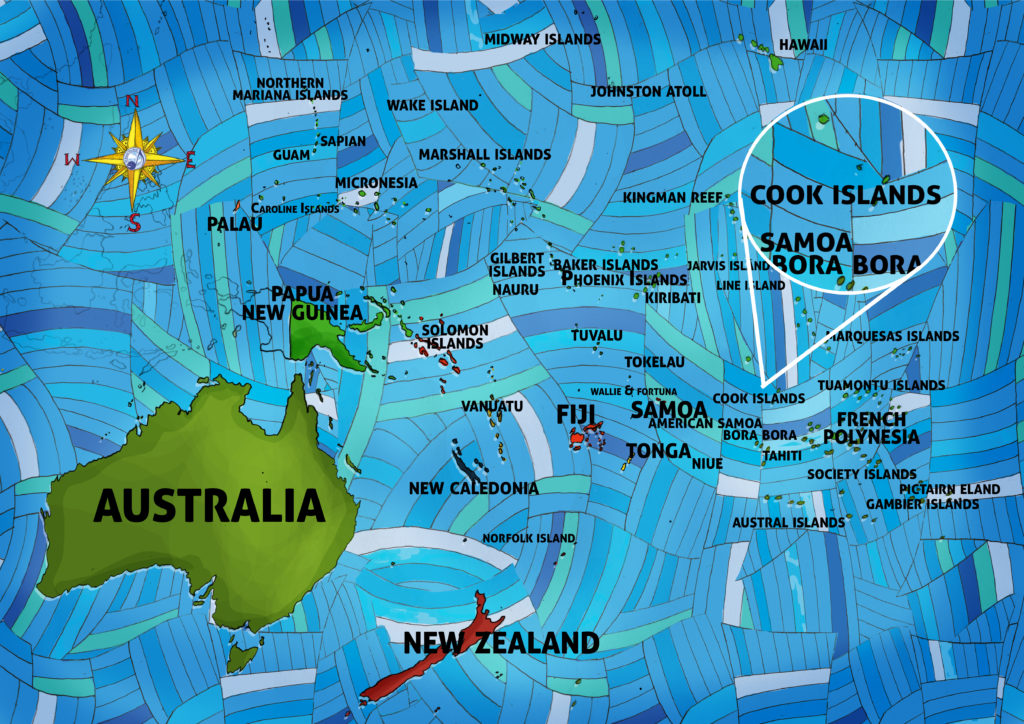We end our week in the Cook Islands by singing a Pacific welcome song. Let’s greet visitors to the awesome atoll of Manihiki with “Tipo Tipo” — “Welcome to our island home of coconuts and pearls, welcome to every mom and dad, and every boy and girl…..”
Tag Archives | Cook Islands
An Astounding Atoll
One of the favorite songs in our season of music from Oceania and the Pacific Islands is a tune from the Cook Islands we call “Tipo Tipo,” a welcome song from Manihiki, a spectacular Pacific atoll. Manihiki’s atoll, which is essentially shaped like a triangle, is the top of a mountain that rises 13,000 feet from the ocean. Its primary industry is the cultivation of black pearls; the few tourists who visit can visit pearl farms in between stunning sessions of snorkeling or scuba diving. There is a small airport — a 3 1/2 hour flight from the nearest big island, the Cook Islands’ Rarotonga — but “Tipo Tipo” tells the tale of the one boat that would arrive weekly, bringing goods from other islands and, occasionally, visitors from distant lands. This video introduces us to Manihiki. Tomorrow we’ll sing.
We Immerse Ourselves in ‘Imene Tuki
‘Imene tuki are a heavenly hybrid, songs that infuse Church hymns with cascading multi-part harmonies and elements of pre-colonization chants that capture the musical spirit of the Cook Islands. We introduce kids in our online classes we do so with enthusiasm, humor and, if we can manage, confident Polynesian flair.
Many Kinds of ‘Imene
Cook Islanders express their culture exuberantly, especially when they sing ‘imene, a genre of music that not only covers contemporary songs, like Cook islands string bands, but also traditional music, like ‘imene reo metua — songs that Protestant missionaries brought to the islands in the 1800s — and Ute, celebratory songs that are essential to Cook Islanders’ social gatherings. Tomorrow we’ll meet one more kind of ‘imene: “‘Imene tuki!”
Taking Action in the Cook Islands
The music of the Cook Islands is rhythmic, harmonious and lively. Drumming forms the foundation of traditional music and dance from the Cook Islands, for example, in “action songs” in which drumming sets the tempos and ukuleles and guitars play the melody. Many of the popular drums in Polynesia such as the Pate and the Tokere may have originated in the Cook Islands, though they arrived in French Polynesia in the early 1900s and have since become identified with Tahiti.
Kia Orana Day
Yesterday we began a wonderous week of wanderings in the Cook Islands. Let’s start by celebrating Cook Islands culture. In other words, Happy Kia Orana Day!
Though each of the Cook Islands has its own unique shades of culture, a common strain running among them is a social organization based on chiefs, families (clan) and a lack of individuality as opposed to integration with the village or family group. The chiefdom primarily passed along the male bloodline, while land rights passed down the mother’s line. Among other duties such as leading the village in war, chiefs were responsible for the all-important sharing of food and giving of gifts; the greatest chiefs threw the best parties. Www.ck also suggests Cook Islands society has a Greek-style “heroic” strain, meaning that in the islands a man would acquire power by developing a reputation of having accomplished admirable deeds.
A Hundred Square Miles of Land in 700,000 Square Miles of Ocean

This week in our online class we visit the Cook Islands, a group of fifteen Polynesian volcanic islands and atolls — 93 square miles of land spread widely over 690,000 square miles of ocean. According to the history page of www.ck, “Cook Islanders are true Polynesians, the finest seafarers of the vast Pacific, voyagers on frail canoes who felt at home on the ocean and who traveled across its huge wastes in search of new lands and new beginnings.” The first record of these “true Polynesians” appearing on the Cook Islands came from about the years 600 to 800 A.D. when settlers are believed to have migrated from other Polynesian islands such as Tahiti, Samoa and Tonga.
The islands, which exist as a self-governing democracy, even as they are considered to be “in free association” with New Zealand., exist two distinct groups. The Southern Cook Islands, which include the most populous island, Rarotonga. Actually the largest population of Cook Islanders is not in Rarotonga, or anywhere in the islands themselves, but in New Zealand. In 2006 about 14,000 people lived on Rarotonga. In 2006, 58,000 in New Zealand self-identified as being of Cook Island descent.
The Coolest Choirs are in the Cook Islands
We start our lesson this week in the Pacific Islands with a fascinating fusion of international music and indigenous song. ‘Imene tuki is a kind of music that is unique to the Cook Islands in Polynesia, but bears some resemblance to church music throughout the region, which features cascading multi-part harmonies and elements of pre-colonization chants, such as guttural grunts to emphasize particular parts of the songs.

